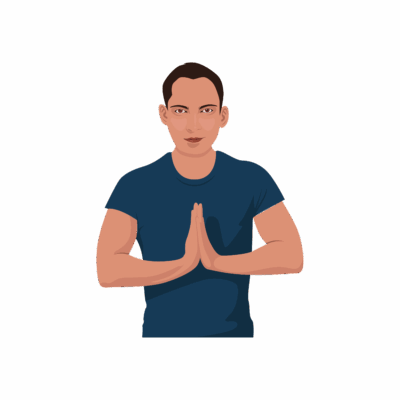Reverse Phalen’s (Prayer) Test
The Reverse Phalen’s Test, also known as the Prayer Test, is a provocative maneuver used to help diagnose carpal tunnel syndrome (CTS). It increases intracarpal canal pressure by placing the wrist and fingers in full extension. This contrasts with the classic Phalen’s test, which flexes the wrist.
How the Test is Performed
-
Client position: Sitting or standing, forearms parallel to the ground.
-
The client places both palms together in a “prayer” position, with wrists and fingers in complete extension, elbows may be held out, and forearms horizontal.
-
The client holds this posture for 30 seconds to 2 minutes.
-
A positive test: Numbness, tingling, burning pain, or “pins and needles” appear in the thumb, index, middle, or lateral half of the ring fingers (median nerve distribution).
-
A negative test: No symptoms are reported within the time frame.
Clinical Significance
-
The Prayer Test results in a significantly higher intracarpal canal pressure than the classic Phalen’s Test, especially in the initial 10–20 seconds.
-
It may provoke symptoms in individuals with CTS who have a negative Phalen’s test, adding sensitivity to screening for CTS.
-
However, its sensitivity and specificity are lower than the classic Phalen’s test, so it is best used alongside other clinical findings and tests.
Assessment
-
Perform the Reverse Phalen’s Test in clients with hand/wrist numbness, tingling, pain, or weakness, especially those who use their wrists in extension (keyboard, manual labor, cycling).
-
Document the time to symptom onset, the quality and distribution of symptoms, and compare with the classic Phalen’s test for a comprehensive assessment.
Treatment
-
If positive:
-
Avoid deep, repetitive, or compressive manual therapy over the carpal tunnel and median nerve.
-
Focus massage on gentle soft tissue release for forearm flexors/extensors, myofascial work for proximal compensatory tissues, and postural correction to minimize carpal tunnel pressure.
-
Educate about wrist extension avoidance during daily activities, ergonomic adjustments, wrist splint use, and rest breaks to relieve symptoms.
-
-
Consider integrating median nerve glides, safe self-mobilization, and activity modifications as part of self-care recommendations.
Safety and Referral
-
Refer clients for medical evaluation if symptoms are persistent, severe, or progressive. CTS can cause muscle wasting and chronic dysfunction if untreated.
-
Collaborate with hand therapists and occupational health providers as needed for clients with moderate/severe symptoms or complex cases.

